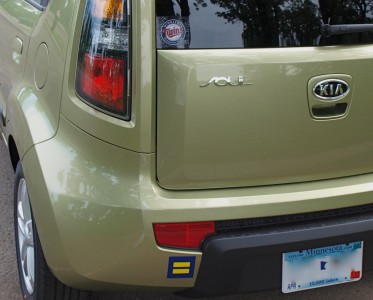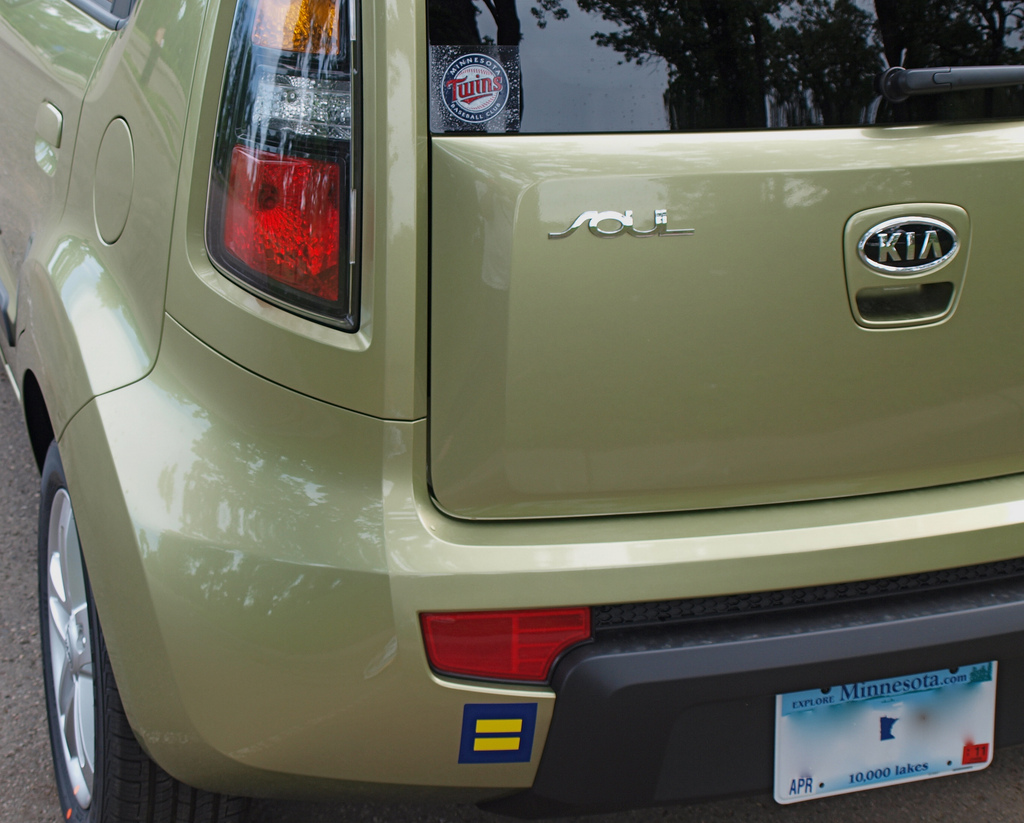Note: This is a guest post from one of Gaywheels’ newest contributors, Randy Stern. It was originally published on his blog, RandyStern.net.

As motorists, we have a tendency to individualize our rides. It’s the American way.
Our nation is one of the few countries where our vehicles are personalized with stickers, cling placards, and badges. Through these identifying marks, we advertise our educational history, faith, favorite sports team, sense of humor, and politics.
In the past decade, we’ve seen a shift in how LGBT motorists personalize their vehicles. In the 1980s and 1990s, some folks slapped pink triangles onto their vehicles, but it was the six-color rainbow flag – now, the de facto banner of the LGBT community – that became the most visible symbol on our cars, trucks and SUVs. It has survived many permutations: strips, cutout shapes, metallic finishes, etc. And of course, it has inspired the flags of our vibrant subcommunities, like the Leather Pride flag, the Bisexual Pride flag, the International Bear Brotherhood Flag. It is not flying on any flagpoles as of yet, but give it time. Those who support these causes can always fly it outside their homes to show solidarity.
In the early 21st century, though, the rainbow flag has nearly been supplanted by something more iconic. The new sticker of choice is simple, non-threatening, and very political: the Human Rights Campaign logo.
In 1980, HRC began as an advocacy organization representing the LGBT community. Its logo is a yellow equal sign on a medium-dark blue background. Designed for HRC’s rebranding in 1995, that logo has become one of the most popular symbols of our community.
You can see it on cars, trucks, SUVs, crossovers, motorcycles, bicycles, and backpacks. In fact, there seem to be more HRC stickers on display than ever before. Even our heterosexual allies have them on their vehicles.
But this raises an interesting question: does the HRC logo speak to us as a symbol of our community? You’d be surprised how many LGBT people are either unaware of what the HRC does, or disagree with the organization’s agenda.
Then too, some people consider the HRC logo too overtly political. Those folks often prefer displaying a variation of the rainbow flag — either the original, or one of its variants. In the subculture I inhabit – that of bears – our earth-toned, seven striped flag doesn’t even register with most of the straight passersby who see it on other cars. For the rest, however, it’s an attention-grabber, alerting us to check out the driver as we cruise by.
But for many, many others, the HRC logo is a perfect blend of the personal and political. As we motor along to work, to the grocery store, and the gym, that blue square with the yellow equal sign is now the most prominent way to let the drivers both gay and straight, from the left and the right, know that we’re here.

the only sticker on the back of my cars is an American flag.
Remember South Korea doesn’t recognize same sex unions of any type. So it’s not surprising that Kia or Hyundai wouldn’t do anything here. But here’s the thing discrimination against LGBT people is a hate crime anyways and I don’t think the company is against LGBT equality I think it would just rather not take a side… I would still buy a Kia or a Hyundai… I like their cars and I’m not fueling Detroit’s corporate greed, and Toyota’s going through another change that I’m not a huge fan of. Honda well there aren’t really any Honda dealers in north metro suburban Minnesota. Volvo is too expensive and again lack of Dealers. Ford is Detroit corporate greed, Chrysler Group is again Detroit corporate greed, GM also Detroit Greed. Volkswagen is kind of boring.